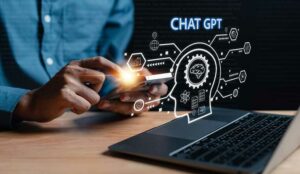Talkdesk’s Ben Rigby explores GPT-4 and the customer service agent of the future.
So. GPT-4 is out. You’re probably feeling overwhelmed about the avalanche of news about ChatGPT and large language models (LLMs).
But if you’re working in the contact centre at any level, this is the most important trend to track. There’s very little about what you’re doing today that will look the same in two years.
As a quick primer, GPT-4 is the next evolution of the LLM that sits at the heart of ChatGPT. It’s the AI model that responds to your query when you ask ChatGPT a question or to complete a statement.
When you ask, “What are the top 10 methods for enhancing customer experience?” it answers your query or completes your thought using everything it has learned from an inconceivably large amount of training data. GPT-3 was the previous version of the model powering ChatGPT.
GPT-4 is a step up from GPT-3. It’s more accurate, detailed, and precise. It can take image inputs and produce a text output. To put this in real-world terms, imagine that your internet provider’s contact centre is empowered with GPT-4 and your internet goes down.
The agent or virtual agent would ask you to take and share a photo of the inscrutable, blinking lights on the front of the modem.
The agent could then ask GPT-4, “What’s wrong with this modem?” And GPT-4 might respond, “Red on the port labeled ‘Diag’ means that the wifi antenna is malfunctioning.” No need for a lengthy conversation or fumbling around to get to the core of the problem.
It’s not to say that GPT-4 is infallible. As OpenAI says, it delivers the “best-ever results (though far from perfect) on factuality, steerability, and refusing to go outside of guardrails.”
OpenAI is keenly aware of the criticism of these models in terms of how they tend to produce inaccurate and biased outputs. Of course, this is our number one concern using these models in the contact centre.
GPT-4 Passes the Bar.
While OpenAI provides a number of benchmarks showing its performance improvement, the one that’s most relatable is its performance on the bar exam—the test that people take to become lawyers in the United States.
GPT-3 scored in the bottom 10% on the exam. GPT-4 scores in the top 10%. You heard that right, GPT-4 not only qualifies to become a lawyer in the U.S. but passes with flying colors.
Just for comparison’s sake, John F. Kennedy, the 35th President of the United States, failed the bar exam twice before passing it on his third attempt.
By the way, GPT-4 also passes demanding university admissions exams including AP Art History, AP Biology, SAT, GRE, and LSAT.
And for good measure, GPT-4 is also a certified sommelier. So be sure to bring GPT-4 to your next fancy dinner for a good wine pairing recommendation (and maybe some good conversation about art history if your date is a dud).
GPT-4 and the Customer Service Agent of the Future.
For the contact centre, the role of the customer service agent of the future has never been more clear. Entry level agent jobs are going away. Humans just won’t need to answer calls, emails, and SMS.
Except in emergency scenarios, almost all incoming requests to the contact centre will be first handled by an automated system.
This automated system will have a short conversation with the customer to understand their issue and kick off a resolution process.
The traditional triage function once performed by humans will no longer be necessary. This is the contact centre equivalent to the toll booth on bridges.
GPT-4 removes any doubt that we need humans to perform this function. Of course, we may want humans to continue to greet customers.
No argument there. But like the toll booth, it’s hard to imagine bridge operators continuing to hire humans to do this job.
Following triage, automated systems will then attempt to resolve up to 80% of customer service inquiries. Consider the level of difficulty for most of us to pass the Bar, the GRE, or AP Art History.
These are not easy tests and require months of study and preparation. There’s an entire billion-dollar industry that helps us get ready for these tests.
Solving most customer service issues does not require that much preparation, and GPT-4 is already passing these exams.
With GPT-4, there is no technical factor that prevents an automated system from quickly and correctly resolving 80% of customer issues.
The question is really more about how we, as customers, are willing to interact with automated systems and how quickly companies will offer automated systems comprehensively.
On that last question, if companies continue to see customer service as a cost centre, my bet is that they move quickly to comprehensive automation. I don’t necessarily think the cost-centre perspective is the right one. But that’s often the status quo.
What does GPT-4 mean for the future of the contact centre agent? Here again, I’ll make a prediction. Contact centre agents of the future are going to fall into two camps:
- High value agents – handling the most complex and empathy-needing conversations (the 20% that aren’t automated).
- Steering agents – agents who are overseeing a team of bots, helping those bots to get back on track when they have issues.
A steering agent is a new concept that I’m presenting here for the first time. With GPT-4 and the LLM trendline in sight, I’ve got a strong conviction that most agents of the future will perform in this capacity.
Imagine dozens of conversations happening simultaneously across voice, email, SMS, chat, and Whatsapp between a customer and a bot.
When the bot needs help, it raises its hand and the steering agent then helps the bot get back on track. In rare cases, the agent may take over the conversation.
As the agent gets better and better at steering, they are able to oversee more and more conversations. So the brand new agent might be able to oversee two simultaneous conversations.
While the expert will oversee dozens. This specialized steering agent will get really good at helping the bot serve customers without noticeable interruption.
I know you may look at this scenario as a kind of robot dystopia. But I bet we’ll all come to look at it more like the toll booth, where it’s both less expensive for the business operator and also more delightful for the end customer because it’s faster and friction-free.
Who knows? Perhaps it will also open up an avenue for the perspective of the contact centre as a value driver instead of a cost centre, which will create new opportunities for human agents in the context of remote customer service. There’s a great unexplored opportunity there.
What is for sure, the genie is out of the bottle and ChatGPT and generative AI will have a profound impact on customer service and the contact centre in the near and short term.
The innovations are coming fast and furious. GPT-4 is the latest salvo in the battle for AI supremacy, and I don’t expect Google or the other generative AI platforms to be sitting idle for long.
Rest assured, we are dedicated to integrating this transformative technology into the contact centre, and we will continue to provide our insights and experiences to help you craft a customer experience strategy that will take you into the future.
This blog post has been re-published by kind permission of Talkdesk – View the Original Article
For more information about Talkdesk - visit the Talkdesk Website
Call Centre Helper is not responsible for the content of these guest blog posts. The opinions expressed in this article are those of the author, and do not necessarily reflect those of Call Centre Helper.
Author: Talkdesk
Published On: 23rd Mar 2023 - Last modified: 24th May 2024
Read more about - Guest Blogs, Ben Rigby, ChatGPT, Talkdesk






 Talkdesk is a global customer experience leader for customer-obsessed companies. Our contact center solution provides a better way for businesses and customers to engage with one another.
Talkdesk is a global customer experience leader for customer-obsessed companies. Our contact center solution provides a better way for businesses and customers to engage with one another. 












